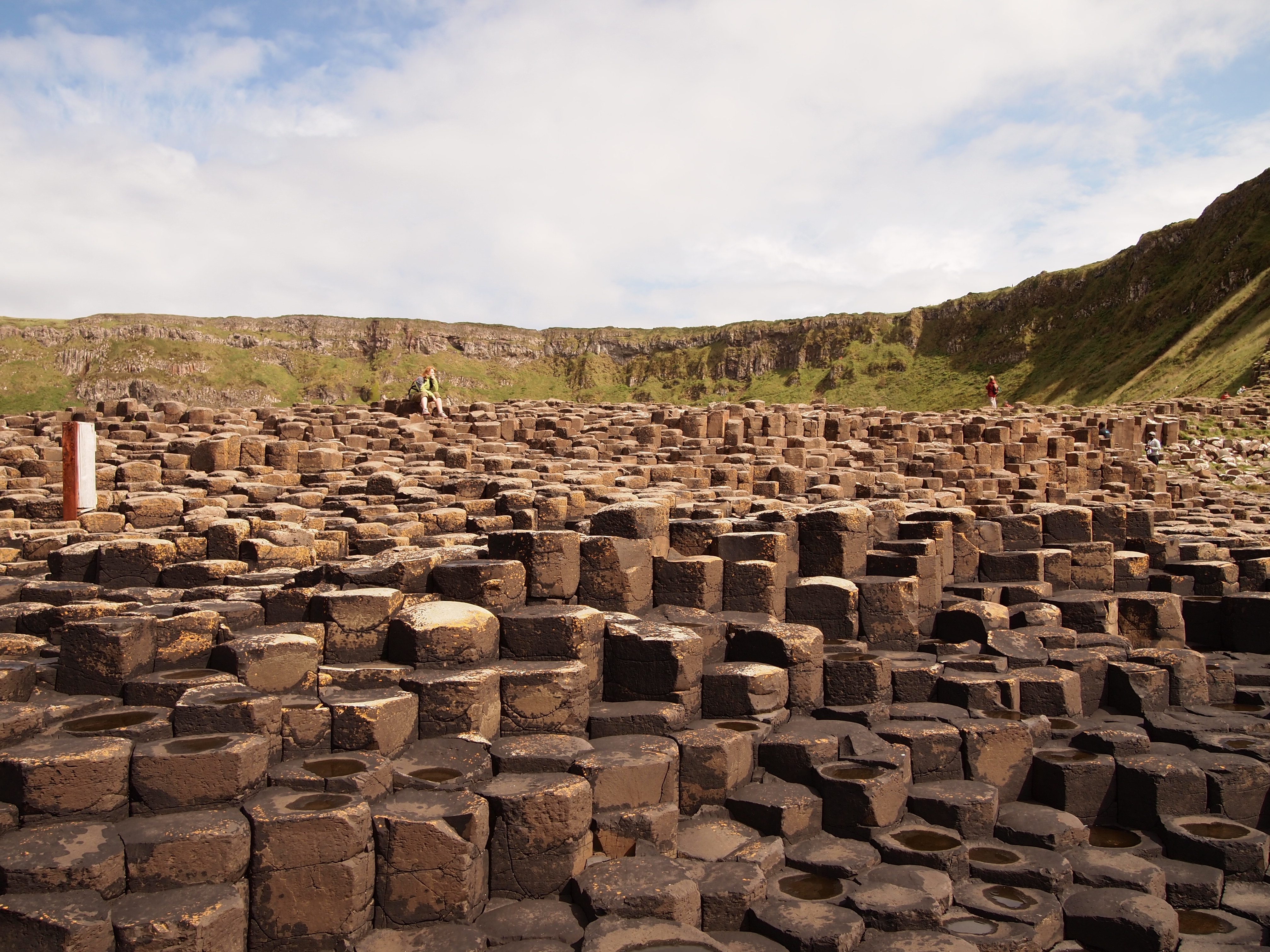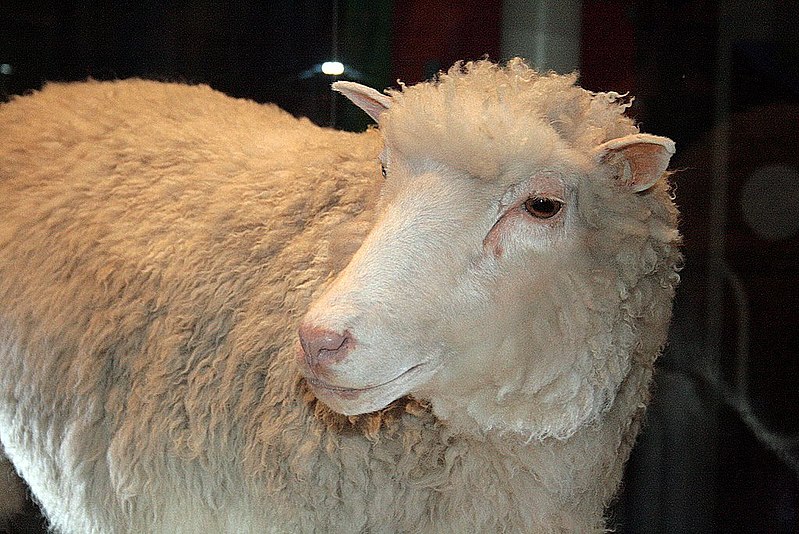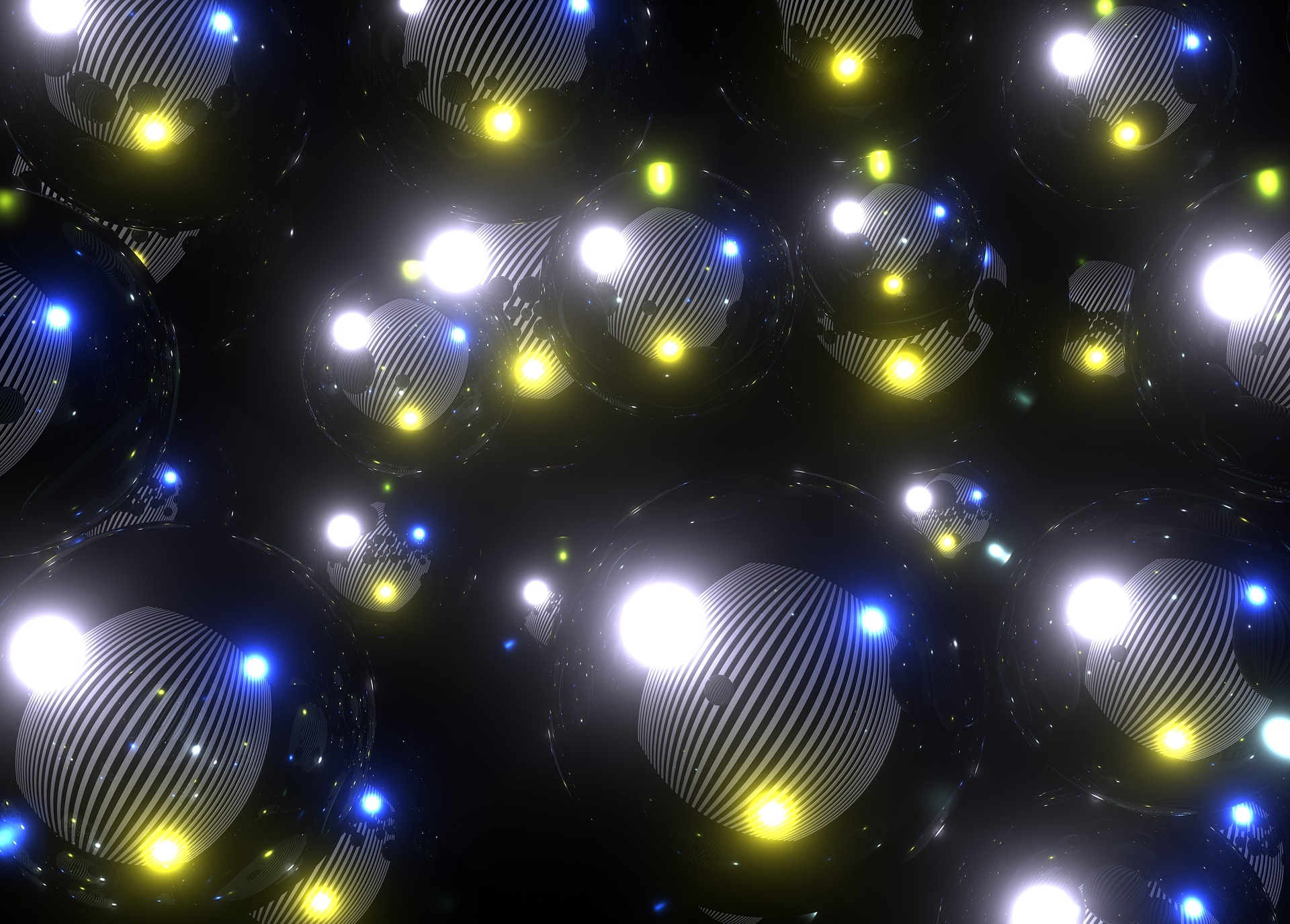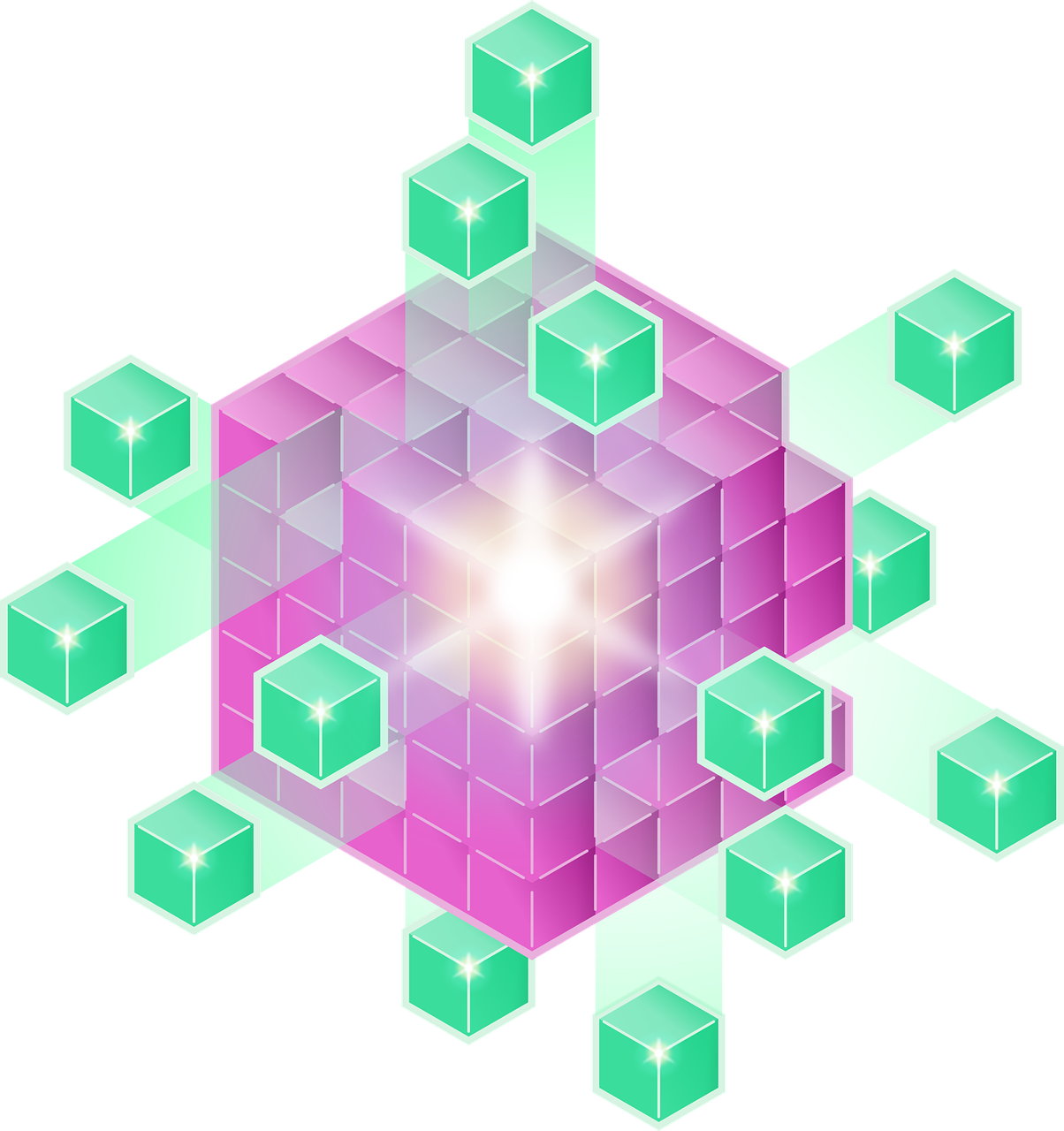N. D. Hari Dass
(Visiting faculty, TIFR Hyderabad)

An example of classical copying in nature is the Giant Causeway in Northern Ireland,
an area of about 38,000 interlocking basalt columns, the result of a volcanic eruption 60 million years ago. (By geolman, Source: http://www.geodiversite.net/media543,
http://www.geodiversite.net/auteur5
Why talk of a Dolly in the quantum context? Dolly, the sheep, was a clone. Clones are supposed to be perfect copies of their original. In the case of Dolly, the original is a living entity, hence all the excitement! In the non- living context, we are familiar with a Xerox Machine. An ideal Xerox machine would make perfect copies of the original. It can also make an arbitrary number of copies. So, what is the big deal, you might ask. The big deal is that in the quantum world, such copying is in general, impossible! This is a very deep result that sets the quantum world in deep contrast from its classical counterpart. To appreciate the significance of it requires a careful dissection of the classical and quantum world. As of today, the scientific consensus is that our world is governed by quantum mechanics. What then do we mean by a classical world? The point is that in an approximation to the quantum world one obtains the so-called classical world which seems to govern pretty much most of the macroscopic world around us. But the laws governing such a macroscopic world were discovered first, for obvious reasons, and this is what one means by the classical world. That world, which included such magnificent creations like Galileo’s inertia, Newton’s laws, Maxwell’s electrodynamics, and even Einstein’s special theory of relativity, went a long way in accounting for the world around us. Important to the dissection we wish to undertake is a clear delineation of the structures of the two theories. All theories start with the primitive notion of states. In classical mechanics, the state of a point particle is specified by its position and its momentum at the same instant. The other aspect of theories is Dynamics. This is the prescription by which given the state of a system at one instant one can uniquely determine the state at a later instant. In classical mechanics, this dynamics is described by Newton’s laws. For the purposes of this article, the detailed form of these laws is not very relevant; nor is it important that these dynamical laws can be recast in vastly different (but physically equivalent) forms like Lagrangian or Hamiltonian forms. When there are many different particles, the state of the composite system, in classical theory, can be construed from the states of the constituents. A concept crucial to our subject of focus is that of measurements.

A close-up of Dolly in her stuffed form. (By Toni Barros from São Paulo, Brazil, Source: flickr.com)
In classical physics, there are two central aspects to be remembered i) no separate laws other than the dynamical principles are needed to describe measurements, ii) there are certainly errors but these can be controlled and compensated with the consequence that measurements do not affect the state of the system measured. For classical copying, this leads to another subtle aspect; a perfect Xerox machine can make perfect copies whether or not the state (in this case the document being copied) is known before hand or not. You may be puzzled as to why this apparently irrelevant detail has been brought in! You will appreciate this when we turn to quantum theory later on. You may even wonder what exactly it means for the copier to know the document beforehand! Think of the machine as a general purpose one which can print and scan. Usually, in Xeroxing, the document is scanned and then printed. First, think of a machine which can take an input file and make copies of its contents. This is what we would call perfect copying of a known state. Now, consider feeding to the machine for which no such input file has been provided. We call that copying of an unknown state. In the classical context, as we know too well, this hardly makes any difference. In the unknown state case, the machine scans the unknown document and then prints or copies it as a known document. Crucial to this is the possibility, both in principle and nearly always in practice, of scanning without mutilating the document. You may be wondering what all this rambling about Xerox machines has to do with differences between classical and quantum world. A most dramatic difference between them comes from the role of measurements in them. The scanning we alluded to is, in fact, a measurement. As already emphasized, in principle, measurements in classical physics need not affect the state of the system and hence, even if a state is unknown, such a measurement can be made to know it fully without distorting it and that knowledge can be used to make perfect copies. It is here that fundamental and dramatic differences arise between quantum and classical theories. It is instructive to recall the meaning of states in quantum theory and though a full elucidation requires technicalities, I will try to give a flavour of it which is as faithful to the precise characterization as is possible in a verbal account like this. In the classical case, the state of a particle was specified by all the components of its position as well as by all components of its momentum. A measurement of these quantities will return precisely these values and the state after the measurement is the same before. In fact, one can measure any property of the system, like for example, all the three components of its angular momentum or for that matter, all components of its Runge- Lenz vector etc. The point is all these are functions on phase space which is the space of states of a classical theory. In effect, all this results in a deterministic description. It is difficult to give such a linear narrative in quantum theory. Heisenberg’s matrix mechanics is somewhat better suited for this even though Schrödinger’s wave mechanics is a physically equivalent description of the quantum theory. Both these were completed in 1925. According to Heisenberg, the observables of classical theory like momentum and position were now to be treated as not only operators but non-commuting operators. If you feel uncomfortable with what operators are, think of them as matrices. A natural question that arises is about the value of an operator or if you so wish, the value of a matrix. A matrix has rows and columns of numbers, complex in the most general case. Which of these is the value of the matrix? Are any of them the value of the matrix?
Mathematically speaking, none of these rows and columns of numbers gives an intrinsic characterization of the matrix as they depend on the basis chosen for representing the matrix. The situation is exactly analogous to that of the components of a vector which can always be changed by choosing different basis vectors, without changing the vector itself. Mathematically speaking, one can attach values to an operator (matrix)! These are the so-called eigenvalues! So, can these eigenvalues be taken as the values of the physical observables which are to be taken as operators in quantum theory? Recall that in classical theory too, the values of observables depend on the states in which they are observed. So if eigenvalues are to be taken as values of observables in quantum theory, what are the corresponding states? Taking a cue from the Matrix theory, one would say the eigenstates of the operator in question. This line of reasoning was adopted by Heisenberg for the Hamiltonian or energy operator, and extended to all observables by Dirac. It is important to add here that for the eigenvalues of physical observables to be real as would be required by the reality of values of physical observables, the corresponding matrices have to be Hermitian. With these preliminaries, we can raise more pointed questions about quantum measurements. So, it is reasonable to surmise that if an observable is measured in one of its eigenstates then the outcome is the corresponding eigenvalue. But does such a measurement affect the state? In the absence of any clear guidelines, let us see if what happens in the classical case is a possibility. Therefore for every state, the act of ideal measurement did not affect the state. In the quantum case, there is no reason why that should be so. But let us see what happens if we require this to be so for eigenstates only. We see that the rule is at least self-consistent in the following sense: if we perform the same measurement again, we get the same eigenvalue we got before and the state after the measurement is again the same eigenstate. That alone is not enough to validate this as a rule. But the great mathematician- physicist von Neumann showed in more technically convincing fashion this type of measurement is indeed permissible in quantum theory. Now comes the real crunch! If you take two 2×2 non-commuting Hermitian matrices A, B (simplest possibility) and look at their eigenstates (you can take any two of the so- called Pauli matrices), you will find that the eigenstates of the first matrix are linear combinations of the eigenstates of the second. Let us consider one of the eigenstates of the A matrix, with eigenvalue, say, a1; then this will be found to be a linear combination of the eigenstates of B, with eigenvalues, b1 and b2. As per the interpretation proposed just now, the eigenstate of A with eigenvalue a1 is a physical state in quantum theory and if we measure the observable A we will get a1. At the same time, this is a linear combination of the eigenstates of B with eigenvalues b1, b2 (which are not equal). But each of these eigenstates of B is also a physical state in quantum theory by the same logic. Putting all this together, one comes to a dramatic conclusion! This is the Principle of Superposition of States.

An artistic imagination of the microscopic quantum world of atoms and molecules
In the present context, the physical state |a1> (this is the modern notation to denote a vector in the so-called Hilbert Space) which has the definite value a1 for the observable A, is a linear superposition of physical states |b1>, |b2>, which however have definite values b1, b2 for the observable B. Note carefully that the latter two states have no definite values for the observable A! I wish to clarify a somewhat technical point to avoid misunderstandings at this stage. Actually, physical states are not represented by the vectors like |c> in Hilbert space; they are actually represented by so- called rays in Hilbert space. This means two vectors in Hilbert space differing by a phase factor represent the same physical state.
I want to strongly emphasize that you may have heard of superposition principles in many other contexts, for example, superposition of vectors in vector algebra, of sound waves, of electromagnetic waves etc. This superposition principle in quantum mechanics is like nothing you have heard before! To appreciate, let us enquire what outcomes of different measurements will be on |a1>. If we measure A, our rulebook so far says that the outcome will definitely be a1 and the state after the measurement is the same as the state before. So far, so good! Next, instead of measuring A on |a1> let us imagine measuring B on it. What will the outcome be? Not only is the state in question not an eigenstate of B, it is actually a superposition of two eigenstates of B with mutually exclusive eigenvalues! The rule book that we had does not say clearly what the outcome would be! But every measurement must have an outcome, else it is not a measurement! This impasse was resolved by a daring interpretation proposed by Max Born – called the probability interpretation of quantum mechanics. It is this that makes the classical world dramatically different from the quantum world; which in effect renders the quantum dolly an impossibility! So this interpretation says, if you measure B on |a1>, the outcome will be either b1 or b2, but in an unpredictable way! In other words, the outcomes of the measurement have definite values but the values are realized randomly! What is not random, however, is the probability of occurrence of these values, which is determined by the quantum state |a1> in this case.
Let us dig a little deeper into this, but before that, it should already be obvious that this superposition principle is of a fundamentally different character than all the other superposition principles we have encountered before in physics and mathematics. It is for this reason that we have to emphasize the term states in enunciating this principle. The fact that the outcomes are in themselves random but nevertheless with well-defined probabilities brings another important aspect of quantum mechanics to the fore. It is therefore clear that with only one measurement the outcome, being pure, cannot yield any information and hence no physical significance can be attached to the measurement. But in a realistic measurement in classical physics too, the outcome of a measurement has a random element to it resulting in the so-called statistical errors.
In classical physics, either the state is unaffected or affected in a controllable manner, one could have repeated the measurement on the same copy of the system a large number of times and reduce the statistical errors. Let us see why this luxury is not available in quantum mechanics! Though 13 the outcomes are the eigenvalues of B randomly, consistency would require that if one performed a B-measurement on the state after the first measurement, one should get the same outcome as in the previous step. This is sometimes called the repeatability hypothesis. If we invoke this, the picture that emerges is that not only the outcome is an eigenvalue randomly; the state after that measurement outcome must become the corresponding eigenstate. This means quantum measurements, at least of this type, lead to a dramatic and irretrievable change of state. This is also sometimes called wave function collapse. This immediately makes a repeated measurement of this type on the same copy of the system useless. As this is a very important point, let us go over it carefully. Suppose we start with some state |X> and measure B with the aim of getting some information about it. Let us assume we are provided only one copy of the state. According to what we have said so far, the state we started with must collapse to |b1> if the outcome is the eigenvalue b1. With this single copy measurement we have lost all information about the starting state as the final state is |b1> which knows nothing about the initial state, nor does the eigenvalue b1 have any information about the initial state either! It is only a large number of independent measurements on an equally large number of identically prepared copies of the initial state that we can ever hope to learn about the initial state. For then, we can measure the probabilities of various outcomes and that indeed contains information about the initial state. These are called ensemble measurements.
At this point, it is worth pointing out that since this formulation of quantum measurements from the early days, explicitly realized by the von Neumann model, a wide variety of new schemes for quantum measurements have come up notably the so-called weak measurements and weak value measurements, quantum non-demolition measurements etc. But none them can really avoid the inevitability of ensemble measurements.

An artist’s impression of the impossible cloning in action. Here, quantum states are represented by small cubes
After this long, but essential elucidation of quantum mechanics, we are now in a position to address the main concern of this article, namely, the impossibility of a quantum Dolly! I picked Dolly to dramatize the issue but for the quantum context that may not be the best choice. For one thing, Dolly’s case involved the cloning of a living being (in fact much of the excitement was on that front!), and living beings are very complex. Also, the question of whether the original was a known state or unknown state is also moot. One can always argue that DNA and the genetic code make every living being a known state. Whether the original in the case of Dolly is a single copy or many copies is also moot as in the body of the original there are numerous identical copies of cells and their genetic material. So we shall play it safe and rephrase the impossibility we started with for the case of quantum states. Once again, if the quantum state is known, cloning or making an arbitrary number of copies is no big deal and works in spirit exactly unknown, as in the classical case. Again, if a large enough the same U should clone any state! ensemble of identically prepared states is unknown. Therefore, if |v> is another state, one would given, there is no big deal either. One can make have U|v>|0> = |v>|v>. Unitary ensemble measurements to determine the transformations maintain the inner product state (called tomography) and then use the between two vectors (this is exactly like knowledge of the state to make an arbitrary rotations maintaining angles). This number of copies. The impossibility statement, immediately gives <v|u>=<v|u><v|u> which is also called the no-cloning theorem, states that only possible if <v|u>=0 or 1. But |u>, |v> were it is impossible to clone or make multiple arbitrary, so the only way out is that no such perfect copies of a single copy of an unknown cloning transformation U can exist. Though quantum state. Since only a single copy is this proof makes no reference to quantum available, no measurement scheme can be measurements, there is a peculiar inner used to determine that state (though we only consistency in the following sense. Suppose showed how it works for Von Neumann such universal cloning machines could exist projective measurements, one can show this (by universal, we mean that U is the same for for every type of quantum measurement all input states), then using such a cloning conceivable). Thus, the analog of scanning in machine, we can produce an arbitrarily large the classical Xerox machine will not work. While we have heavily used ideas pertaining to them, we can make ensemble measurements quantum measurements to argue the case, the to determine the state! But this goes against theorem as originally proved by Wootters and the crux of quantum mechanics we stated Dieks, only used the rules for quantum earlier, namely, no measurements on a single evolution (dynamics) to prove it. The proof is copy can yield any information about it. so elegant and straightforward, that I will Therefore, there cannot be such universal include its essentials here. Suppose we want to cloning machines. I end this article with a clone an unknown quantum state |u> into two point that often confuses people when first identical copies. The way to do it is to consider confronted with the no-cloning theorem. They |u> along with a blank |0> (think of this as the cite the laser as a possible counter example. In empty sheets of a classical Xerox machine. a laser starting with an initial photon injected Now let the quantum dynamical process be into a cavity with population inversion, described by a unitary transformation U (all induced emission creates a huge number of quantum evolutions are described by unitary copies of the initial photon. Superficially, it transformations, these are the technical looks like the initial photon has been cloned aspects that you have to learn if you want to and the no- cloning theorem has been violated! get a proper understanding of quantum In a sense, the laser is a cloner, but it clones a mechanics). This means we have the cloning known state as the lasing device has to be transformation expressed by the equation specifically chosen to match the initial state of U|u>|0> = |u>|u>. Since the original state is the photon.
This article was previously published in the December- February issue of the Scienceteen Magazine. About the magazine:
“We noticed that in India there is a requirement of science magazine which is easily accessible and understandable for the teens. We decided on this magazine four years ago and after so much research and the combined efforts of The Mathematical Way Institute and Ramanujan Shodh Sansthan, the idea could be framed. We hope the magazine, that we have been able to put together, gives a new direction to Indian teens and Indian Science education. We want to emphasize that our efforts will give a direction to a policy free science, so that anyone could easily pursue it.”
Rahul Aggrawal, Associate Editor of the Scienceteen Magazine
http://scienceteen.com/category/magazine/

